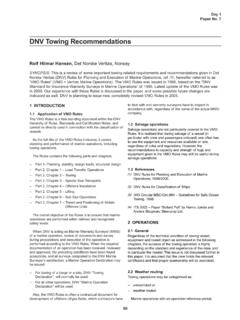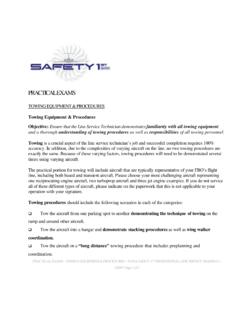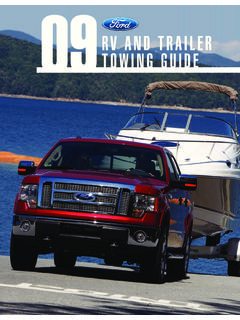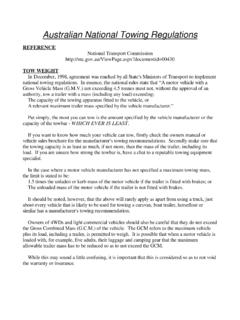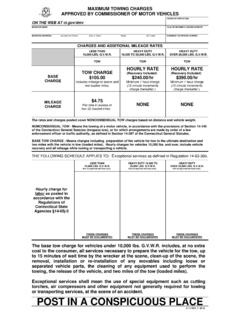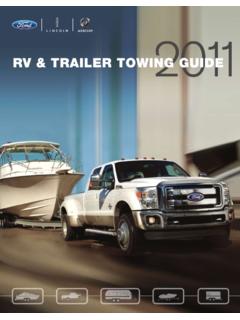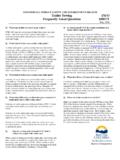Transcription of DNV Towing Recommendations - Tugmasters
1 69 Day 1 Paper No. 7 DNV Towing RecommendationsRolf Hilmar Hansen,Det Norske Veritas, NorwaySYNOPSIS:This is a review of some important Towing related requirements and Recommendations given in DetNorske Veritas (DNV) Rules for Planning and Execution of Marine Operations, ref. /1/, hereafter referred to as VMO Rules (VMO = Veritas Marine Operations). The VMO Rules was issued in 1996, based on the DNVS tandard for Insurance Warranty Surveys in Marine Operations of 1985. Latest update of the VMO Rules wasin 2000. Our experience with these Rules is discussed in the paper, and some possible future changes areindicated as well.
2 DNV is planning to issue new, completely revised VMO Rules in Application of VMO RulesThe VMO Rules is a free-standing document within the DNVhierarchy of Rules, Standards and Certification Notes, andcannot be directly used in connection with the classification the full title of the VMO Rules indicates, it coversplanning and performance of marine operations, includingtowing Rules contains the following parts and chapters: Part 1- Planning, stability, design loads, structural design. Part 2, Chapter 1 Load Transfer Operations Part 2, Chapter 2 Towing Part 2, Chapter 3 Special Sea Transports Part 2, Chapter 4 Offshore Installation Part 2, Chapter 5 Lifting Part 2, Chapter 6 Sub Sea Operations Part 2, Chapter 7 Transit and Positioning of MobileOffshore UnitsThe overall objective of the Rules is to ensure that marineoperations are performed within defined and recognisedsafety DNV is acting as Marine Warranty Surveyor (MWS)
3 Of a marine operation, review of documents and surveyduring preparations and execution of the operation isperformed according to the VMO Rules. When the requireddocumentation of an operation has been received, reviewedand approved, the prevailing conditions have been foundacceptable, and all surveys completed to the DNV MarineSurveyor s satisfaction, a Marine Operation Declaration maybe issued: For Towing of a barge or a ship, DNV TowingDeclaration , will normally be used. For all other operations, DNV Marine OperationDeclaration will be , the VMO Rules is often a contractual document fordevelopment of offshore oil/gas fields, which contractors haveto deal with and warranty surveyors have to inspect inaccordance with, regardless of the name of the actual Salvage operationsSalvage operations are not particularly covered in the VMOR ules.
4 It is realised that during salvage of a vessel (inparticular with crew and passengers onboard) one often hasto use the equipment and resources available on site,regardless of rules and regulations. However, therecommendations to capacity and strength of tugs andequipment given in the VMO Rules may still be useful duringsalvage References/1/ DNV Rules for Planning and Execution of MarineOperations, 1996 DNV Rules for Classification of IMO Circular Guidelines for Safe OceanTowing, ITS 2002 Paper Bollard Pull by Hannu Jukola andAnders Skogman, Steerprop GeneralRegardless of the technical condition of Towing vessel,equipment and towed object as addressed in the followingchapters.
5 The success of the Towing operation is highlydepending on the standard and experience of the crew, andin particular the master. This issue is not discussed further inthis paper; it is assumed that the crew holds the relevantcertificates and that proper seamanship will be Weather routingTowing operations may be categorised as; unrestricted or weather operations with an operation reference period,70exceeding 72 hours are normally defined as unrestrictedoperations. Environmental criteria for these operations shallbe based on extreme value statistics. However, the designcriteria for determination ofminimum Towing forcefor opensea Towing ( unrestricted Towing ) is fixed (see sect.)
6 And not based on actual statistics for the Towing route Towing operation may be weather routed ( weatherrestricted) due to limitations on the towed object. Weatherrouted tows shall seek shelter if weather situations exceedingthe operation criteria are forecasted or experienced. Ports ofrefuge and/or area of shelter shall be defined in the towingprocedures. Entrance, geography and size of shelter shall beconsidered. Weather routing criteria will normally be given asrecommendation on the Towing certificate/declaration issuedby the of category (unrestricted/weather routed) ofthe Towing operation, a tow out criteria of Beaufort Force 5 orbetter for the coming 24 hours is normally applicable.
7 Theintention with the tow out criteria is to allow time forfamiliarisation with the tow, and to ensure adequate distanceto shore in case of adverse weather experience: There have been weather routed towingoperations where the forecast for the route seems notbeing conscientiously assessed onboard the tug, and badweather encountered resulting in towline breakage and/ordamage to the towed object. In principle, such action of thetug master (or lack of action!) may be classified as breachof warranty and may render the insurance of the towedobject Voyage reportingDaily voyage reporting to owners of tug and towed object isnormally required, and should at least contain position, seacondition, speed, ETA and status of tug and towed reports should be copied to the experience: Even if voyage reporting is given as arecommendation on the DNV Towing Declaration, thereport is often not copied to DNV.
8 This is unfortunate incase of incidents occurring during the tow, and may causeembarrassment towards the Towing manualA Towing manual shall be prepared and distributed to manual shall normally contain information regarding; tow out criteria, criteria for seeking shelter, Towing route, ports/areas of shelter, estimated Towing time (ETD, ETA), environmental limitations structural capacity ofobject, seafastening, etc., contingency actions, description of the ballast condition, reporting routines for progress of the tow, ETA, status,etc., contact persons and telephone numbers, expected environmental conditions for the intended towingroute for the relevant season, and procedures for departure and arrival as well as calls atintermediate tow master (usually the tug master) shall familiarisehimself with the Towing Type, size and classification of tugThe Towing vessel can be a tug, an anchor handler, or a typethat combines these functions with several others, and havethe Class Notation Tug.
9 The main requirement is that thevessel must be equipped with a remote operated towingwinch. The background for the Towing winch requirement isat all times to have the flexibility to adjust the length of thetowing line according to environmental conditions, waterdepth, other traffic, and width of the navigated there is no minimum size/length of a tug, butvessels for open sea towage shall not have any servicerestrictions. Note that the VMO Rules penalise tugs of lessthan 45m length with respect to Towing efficiency, see is considering redundancy requirements on criticalsystems (propulsion, steering, winch, etc.)
10 For tugsperforming Towing of high value objects in the next revisionof the VMO tug must, of course, hold valid statutory certificatesand trading permit and will be inspected by the MWS prior tocommencement of the Towing operation. Class is formally notrequired; a certificate from the national maritime authority isalso with a Towing hook only ( no Towing winch) are notaccepted by DNV for ocean Towing , but may be permitted fortowing in harbours or Towing jobs of short duration/length insheltered experience: There have been a few cases where tugshave been turned down at the time of inspection by theDNV marine surveyor due to gross overdue validity ofcertificates or a general unsatisfactory condition of the tug( fuel oil spill/leaks in the engine room).
